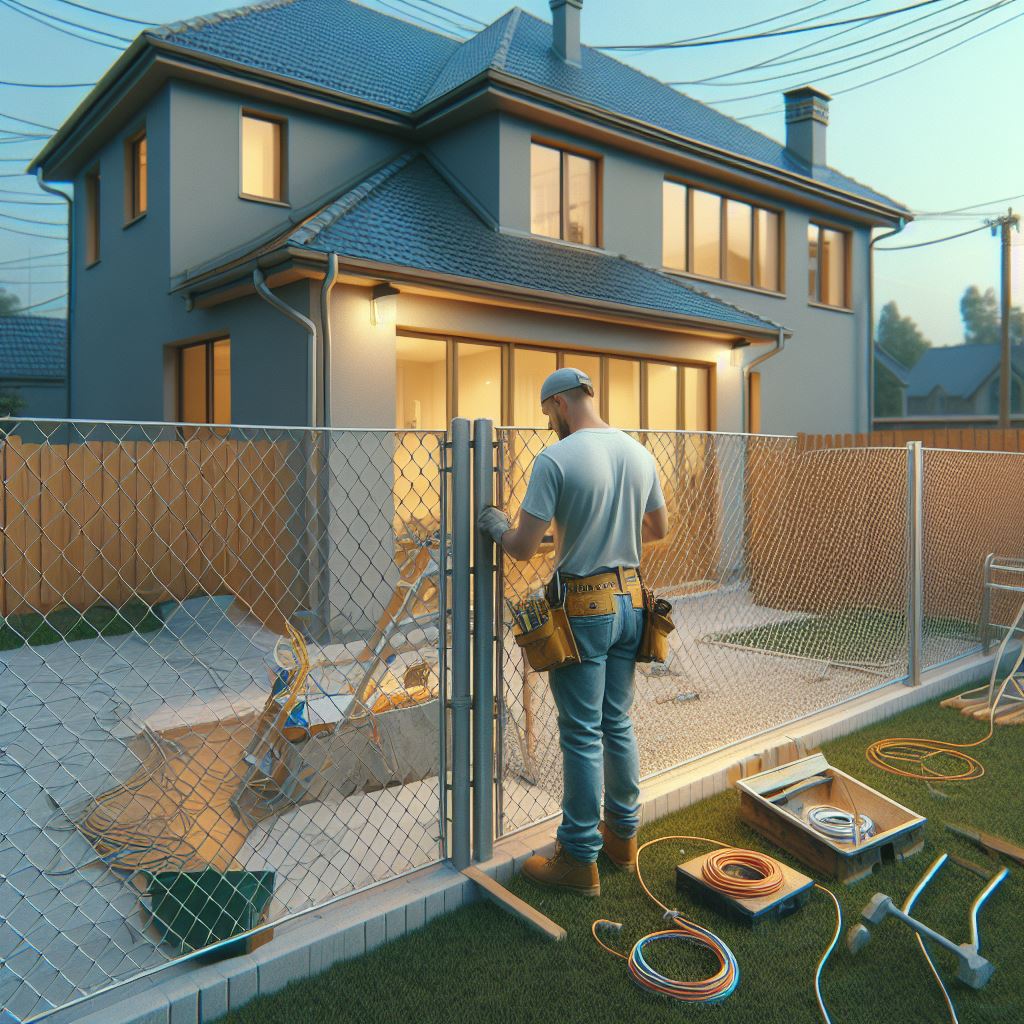When it comes to the practicalities of maintaining a chain link fence, the devil is in the details. These fences are a staple in both urban and rural landscapes across the United States, serving as reliable boundaries for homeowners and construction professionals alike. In this guide, we’ll delve into the importance of keeping these fences in top condition and provide an overview of the skills and knowledge necessary to effectively tackle repairs.

Understanding Chain Link Fences
Chain link fences have woven their way into the fabric of American landscapes. Originating in the UK in the 19th century and gaining popularity in the US in the early 20th century, these fences are prized for their durability and practicality. A typical chain link fence consists of several key components:
- Posts: These steel or aluminum pillars, set into the ground, provide structural support.
- Mesh: The galvanized steel wire mesh, often coated for weather resistance, forms the barrier.
- Ties: Wire or metal ties bind the mesh to the posts and rails.
- Gates: Integral for access, these range from simple pedestrian to large vehicle gates.
Despite their sturdiness, chain link fences are not immune to damage. Weather, wear, and physical impacts can lead to issues like rusting, mesh tears, and post misalignments.

Tools and Materials Needed
In order to effectively address these issues, a well-prepared toolbox and the right materials are essential. Here’s what you’ll need:
Tools:
- Pliers and Wire Cutters: Essential for manipulating and cutting metal components.
- Tension Bars and Stretchers: These tools are invaluable for maintaining the proper tension in the fence mesh.
- Socket Wrench: Crucial for tightening bolts and ensuring the stability of the fence’s framework.
Materials:
- Replacement Links and Fence Ties: Always have these on hand for quick repairs of broken or damaged sections.
- Aluminum Wire or Hog Rings: Ideal for securing the fence ties and ensuring a firm hold.
Safety Gear:
- Gloves and Safety Glasses: Non-negotiable for protecting hands and eyes during work.
- Sturdy Boots: Essential for foot protection, especially when working with heavy tools and materials.

Step-by-Step Guide to Chain Link Fence Repair
Assessing the Damage
In the world of fence maintenance, a thorough assessment is your first line of defense. It’s essential to systematically examine every inch of your chain link fence, much like a doctor would in a routine check-up. Start with a visual inspection, where you scrutinize each section for telltale signs of damage like rust, distortion, or breaks. Then, move on to a physical examination, gently testing the firmness of the posts and the integrity of the links. Feel for loose parts and notice any areas where the fence gives more than it should.
The key here is to understand the extent of the damage. Is it localized or widespread? Often, a fence will only require spot repairs, but sometimes, if the damage is extensive or structural, partial or complete replacement might be necessary. This judgment call is crucial and should be based on the fence’s overall stability and safety, not just on aesthetic concerns.
Repairing Minor Damages
Now, let’s talk about tackling those minor repairs. These are often straightforward fixes that can significantly extend the life of your fence.
- Fixing Loose or Bent Links:
Approach each damaged link like a small puzzle. With a pair of pliers, gently realign any bent links back to their original shape. It’s a delicate balance between applying enough force to correct the shape and not overdoing it to avoid further damage.
If a link is beyond repair, it’s time for a replacement. Cut out the damaged link with wire cutters, then thread a new piece into the gap. This process is akin to darning a hole in a fabric, where careful weaving ensures strength and continuity.
- Replacing Broken or Missing Fence Ties:
Inspect each tie. These small but critical components secure the fence fabric to the posts and top rails. If they’re damaged or missing, they compromise the fence’s integrity.
Removing old ties might require some elbow grease. Use your pliers to untwist and remove them. When installing new ties, ensure they’re wrapped tightly around the post and the fence fabric. This attention to detail ensures a firm, lasting hold.

Repairing Major Damages
In the realm of fence repair, addressing major damages is a task that demands both precision and practicality. Here’s a structured approach to effectively restore your fence’s integrity:
- Removing Damaged Sections:
Begin by isolating the compromised area. Carefully cut through the links connecting the damaged section to the rest of the fence, using bolt cutters for a clean removal.
If the section is attached to a post, loosen and remove the tension bands and bolts with a socket wrench, taking care not to disturb the surrounding structure.
- Replacing the Section:
Measure the gap accurately and cut a new section of mesh slightly larger than needed. It’s easier to trim excess than to compensate for a shortfall.
Fasten the new section to the existing posts, employing tension bands or wire ties for secure attachment, ensuring alignment with the rest of the fence for a seamless appearance.
- Reattaching and Tightening the Mesh:
Introduce tension bars into the end loops of the mesh near the post, providing leverage to stretch the mesh tightly.
Utilize a fence stretcher or a come-along winch to evenly tension the mesh, aiming for tautness that prevents future sagging.
Attach the mesh firmly to the posts and top rails using wire ties or hog rings, ensuring consistent tension throughout the fence.
Post and Gate Repairs
Addressing issues with posts and gates is equally vital for maintaining the overall functionality of your fence.
- Fixing Leaning or Damaged Posts:
For a leaning post, excavate around its base and realign. If the post is unstable, reinforce it with new concrete, ensuring it’s perfectly vertical and in line with the fence.
Inspect for corrosion or structural damage at the base. A compromised post should be replaced entirely, set securely in concrete, and aligned accurately.
- Adjusting and Repairing Fence Gates:
Address sagging gates by tightening hinge bolts, using a socket wrench. If hinges show significant wear, consider replacing them for better functionality.
Ensure that the gate latch aligns properly. Gates may shift over time, necessitating adjustments to the latch for secure closure.
Advanced Tips and Tricks
With extensive experience in the field, I’ve accumulated some advanced tips that can elevate your fence repair skills:
- Ensuring Longevity and Durability:
Apply rust-preventative paint after repairs, a simple yet effective step to extend the lifespan of your fence.
Conduct regular inspections, tightening bolts and ties as needed. This proactive approach can circumvent more significant repairs in the future.
- Creative Solutions for Challenging Scenarios:
In tight spaces, a small hand winch can be invaluable for mesh tightening, providing precision and ease.
For uneven terrain, tailor the fence mesh to match the ground contour. This not only looks professional but also maintains structural strength.
Preventative Maintenance
In the craft of keeping a chain link fence in prime condition, consistent preventative maintenance is key. It’s not just about fixing issues as they arise, it’s about foreseeing potential problems and nipping them in the bud.
- Regular Maintenance Tips:
Regular inspections are crucial. At least biannually, walk along the fence line and scrutinize each section for potential issues like loose connections or signs of wear.
Bolts and nuts can loosen over time. Make a habit of tightening these components during your inspections to maintain structural integrity.
Gate hinges and locks need attention too. Lubricate them periodically to ensure smooth operation.
Cleaning your fence can be as simple as a wash-down with a hose, but for accumulated dirt, a mild detergent solution can be effective.
- Seasonal Care Advice:
Before the onset of winter, double-check that your posts are secure, as freezing and thawing ground can shift them.
Spring is the perfect time for a thorough inspection, to address any damage caused by harsh winter conditions.
In areas where rust is a concern, applying a rust inhibitor with the changing seasons can prolong the life of your fence.
DIY vs. Professional Help
Understanding the balance between DIY endeavors and when to call in a professional is an essential aspect of fence maintenance.
- DIY Repairs:
Small-scale repairs like tightening parts or mending minor tears are great DIY projects. They are cost-effective and can be quite satisfying to complete.
For these tasks, having a basic toolkit is usually sufficient.
- Calling a Professional:
Major repairs, especially those that involve structural integrity, often require professional skills and tools.
Hiring a professional not only ensures the job is done right but may also come with the benefit of a service warranty.
- Cost Estimates:
DIY repairs generally incur the cost of materials only.
Professional services, while more costly, bring expertise and efficiency, particularly for more complex issues.
FAQ Section
For a small tear, use pliers to gently reshape the links or replace a broken link by weaving in a new one, ensuring it’s securely integrated into the fence.
Surface rust can often be treated by sanding and applying a rust inhibitor. However, if rust has compromised the structural integrity, replacing the affected section is advisable.
Regular tension adjustments are crucial. Use a tension bar and tension bands to keep the fence taut and check the firmness of the posts.
Conduct thorough inspections at least twice a year, typically in spring and fall, to identify and address any issues early.
A basic set of pliers, wire cutters, and a socket wrench set are essential. Additionally, a tension bar and a fence stretcher can be invaluable for larger repairs.
